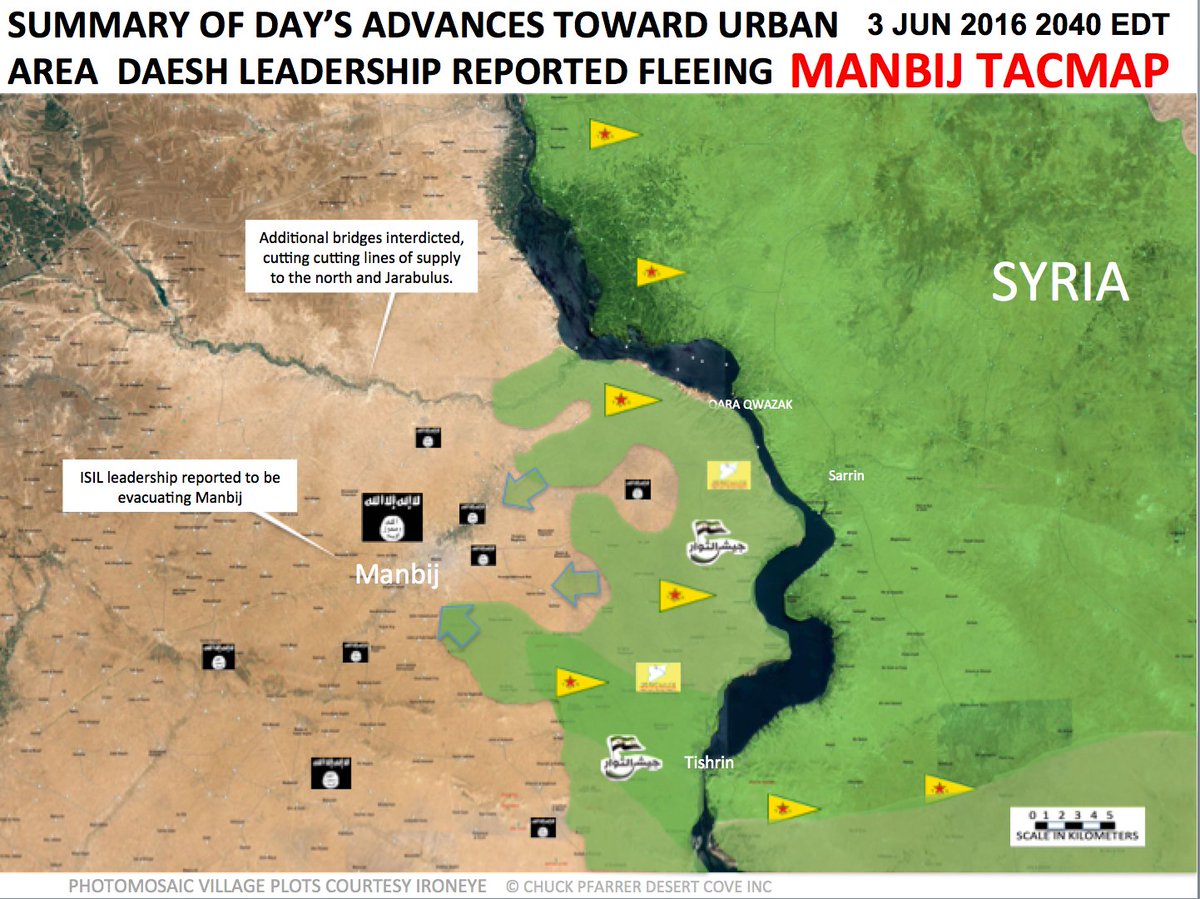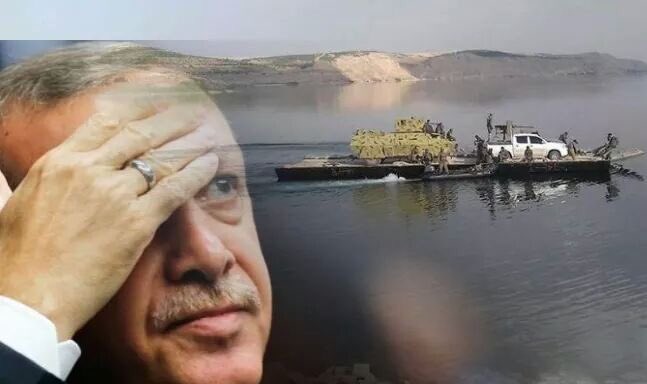Levant crisis - III
Re: Levant crisis - III
Ulan, that news is to be taken with a load of salt.
in march, the SAA had advanced east from Ithriyah on the tabqah road into the western parts of Raqqa province and captured a few hills along the road...they were some 60-100km from tabqah airbase/ISIS den on the river. then many events intervened and they withdraw all the way back near Ithriyah.
now they are just starting to creep east along this road again, with a long way even to reach their previous farthest advance line.
raqqa to bahut door hai. even the SDF is stepping quietly in the east...capturing few villages and hamlets in manageable chunks. I think they do not want a Banzai in Saipan kind of ISIS hornet swarm attack which will result in big casualties and coalition airpower is not scaled up for that level of threat as well.
in march, the SAA had advanced east from Ithriyah on the tabqah road into the western parts of Raqqa province and captured a few hills along the road...they were some 60-100km from tabqah airbase/ISIS den on the river. then many events intervened and they withdraw all the way back near Ithriyah.
now they are just starting to creep east along this road again, with a long way even to reach their previous farthest advance line.
raqqa to bahut door hai. even the SDF is stepping quietly in the east...capturing few villages and hamlets in manageable chunks. I think they do not want a Banzai in Saipan kind of ISIS hornet swarm attack which will result in big casualties and coalition airpower is not scaled up for that level of threat as well.
Re: Levant crisis - III
Peto Lucem Retweeted
Hassan Ridha @sayed_ridha 3h3 hours ago
#SAA have entered #Raqqa province for the first time since 2014 after taking control of Abo al-'Alaj, ~50km to Tabqa
https://pbs.twimg.com/media/CkBwQ5VXIAAmCLg.jpg
Hassan Ridha @sayed_ridha 3h3 hours ago
#SAA have entered #Raqqa province for the first time since 2014 after taking control of Abo al-'Alaj, ~50km to Tabqa
https://pbs.twimg.com/media/CkBwQ5VXIAAmCLg.jpg
Re: Levant crisis - III
americans have supplied some barges to permit SDF vehicles cross the river at qara qwazak. daesh destroyed the bridge
Re: Levant crisis - III
all of that and the US is "uninvited" to Syria.........
Re: Levant crisis - III
meantime, JN/FSA/Shams shelling of aleppo using hell cannons continue with nato member turkeys consent
here a 8 yr old kurdish child has got his groin and one leg ripped to bits
GRAPHIC image: do not open if you cannot stand blood
https://pbs.twimg.com/media/CkGLcWwWsAAJzJZ.jpg
here a 8 yr old kurdish child has got his groin and one leg ripped to bits
GRAPHIC image: do not open if you cannot stand blood
https://pbs.twimg.com/media/CkGLcWwWsAAJzJZ.jpg
Re: Levant crisis - III
I was mistaken, the bridge was captured intact. the videos of barge crossings must be some other point
https://pbs.twimg.com/media/CkBPWgSW0AAjBYi.jpg
https://pbs.twimg.com/media/CkBPWgSWYAAjS47.jpg
kurds are walking and driving slowly to manbij from all directions in east
https://pbs.twimg.com/media/CkBPWgSW0AAjBYi.jpg
https://pbs.twimg.com/media/CkBPWgSWYAAjS47.jpg
kurds are walking and driving slowly to manbij from all directions in east
Re: Levant crisis - III
YPG forces capture van full of weapons from turkey meant for ahral al shams
video https://twitter.com/DrPartizan_/status/ ... 0709476352
https://twitter.com/DrPartizan_/status/ ... 5493636100
video https://twitter.com/DrPartizan_/status/ ... 0709476352
https://twitter.com/DrPartizan_/status/ ... 5493636100
Re: Levant crisis - III

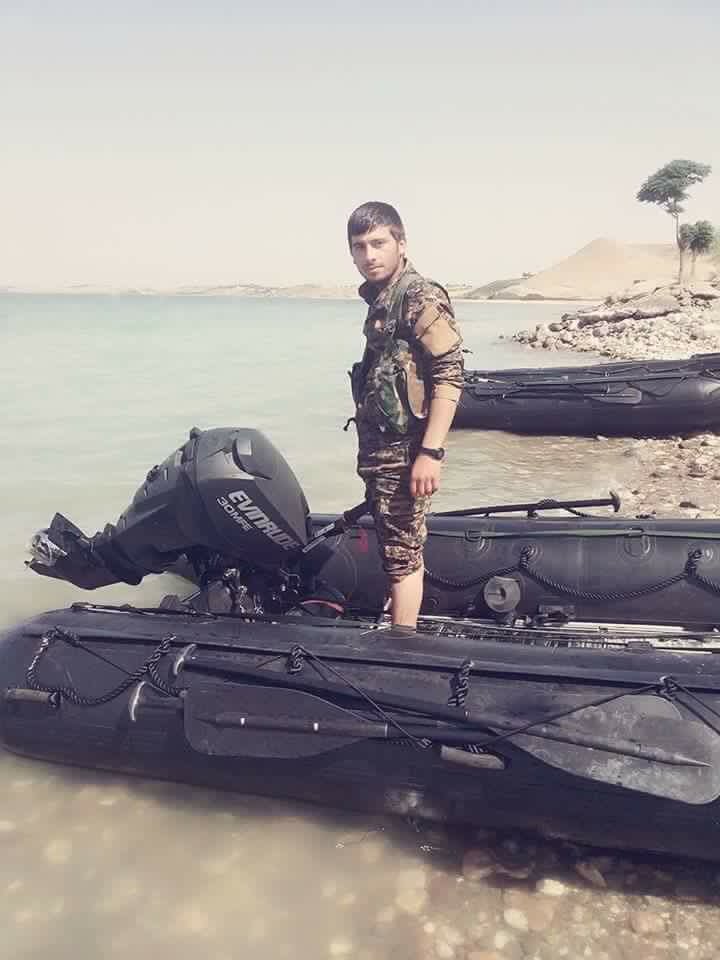
IS seemed to have destroyed the bridge but repaired somehow at both ends
https://twitter.com/DrPartizan_/status/ ... 4123564032
Re: Levant crisis - III
evinrude is a engine maker proudly based in wisconsin 
that new american airbase in hasakah province must have got C130 payloads shipped
that new american airbase in hasakah province must have got C130 payloads shipped
Re: Levant crisis - III
manbij will be surrounded shortly with very light problems. whether the ISIS choses to defend the town or hightail it south is open to question. whether they can send reinforcements from any direction is also open.
probably some fall guys will be left behind while Emirs and elite forces either move north to hug the turkish border for a quick escape or south to raqqa
SDF will surely cleave the ISIS in half by pressing on to el bab
the SAA + russian advisers in west are trying the same thing with the march on Tabqah from Ithriyah
probably some fall guys will be left behind while Emirs and elite forces either move north to hug the turkish border for a quick escape or south to raqqa
SDF will surely cleave the ISIS in half by pressing on to el bab
the SAA + russian advisers in west are trying the same thing with the march on Tabqah from Ithriyah
Re: Levant crisis - III
http://www.al-monitor.com/pulse/securit ... truce.html
Although the mobilization of armed factions in northern Syria has not undergone any change worth mentioning, Lavrov has grown convinced that the Americans are deceiving the Russians and that the international coalition is standing idly by as terrorists and arms flow through the Syrian-Turkish border. [It seems that] Lavrov has come to believe that the terrorists are undoubtedly preparing to launch an offensive in violation of all international conventions and UN Security Council resolutions.
Without stirring a buzz similar to that of their first military intervention in Syria, the Russians this week disembarked ground forces and paratroopers in the port of Tartus to support more than 3,000 Russian volunteers dispatched to the region in the past few weeks, in a bid to revive coordination with the Syrian army.
This represents yet another additional indication that a wide-ranging operation is being prepared. This [operation] may include Raqqa, where the Russians want to have a presence on the ground to rival that of the Americans and Kurds. This may also include the countryside of Aleppo, where the Iranians are pushing for a major operation aimed to cut supply routes open to the east and retake the village of Khan Tuman, where [Iran] suffered a major setback.
In that regard, Syrian sources stated that the Russian joint command staff, which coordinated aerial support operations last fall, had returned to the Hmeimim military base in Latakia province to begin preparations for new operations.
Read more: http://www.al-monitor.com/pulse/securit ... z4AgUNf0ts
Although the mobilization of armed factions in northern Syria has not undergone any change worth mentioning, Lavrov has grown convinced that the Americans are deceiving the Russians and that the international coalition is standing idly by as terrorists and arms flow through the Syrian-Turkish border. [It seems that] Lavrov has come to believe that the terrorists are undoubtedly preparing to launch an offensive in violation of all international conventions and UN Security Council resolutions.
Without stirring a buzz similar to that of their first military intervention in Syria, the Russians this week disembarked ground forces and paratroopers in the port of Tartus to support more than 3,000 Russian volunteers dispatched to the region in the past few weeks, in a bid to revive coordination with the Syrian army.
This represents yet another additional indication that a wide-ranging operation is being prepared. This [operation] may include Raqqa, where the Russians want to have a presence on the ground to rival that of the Americans and Kurds. This may also include the countryside of Aleppo, where the Iranians are pushing for a major operation aimed to cut supply routes open to the east and retake the village of Khan Tuman, where [Iran] suffered a major setback.
In that regard, Syrian sources stated that the Russian joint command staff, which coordinated aerial support operations last fall, had returned to the Hmeimim military base in Latakia province to begin preparations for new operations.
Read more: http://www.al-monitor.com/pulse/securit ... z4AgUNf0ts
Re: Levant crisis - III
Hassan Ridha @sayed_ridha 54s54 seconds ago
#SDF have fire control over road which links #Manbij to #Raqqa after taking Um Saraj, #IS now has to use highway to al-Bab to reach Manbij
#SDF have fire control over road which links #Manbij to #Raqqa after taking Um Saraj, #IS now has to use highway to al-Bab to reach Manbij
Re: Levant crisis - III
Hassan Ridha @sayed_ridha 13h13 hours ago
#SDF are now less than 10km from the south entrance of #Manbij after taking control of Kabirjah village north of Um al-Saraj hill
Hassan Ridha @sayed_ridha Jun 1
According to Reuters; #SDF offensive on #Manbij is made up mostly of Arabs, #YPG will help clear area but Arabs will consolidate/govern it
Hassan Ridha @sayed_ridha Jun 1
A Coalition warplane has destroyed 'Awn al-Dadat bridge north of #Manbij which links to #Jarablus

Hassan Ridha @sayed_ridha Jun 1
Coalition has also reportedly destroyed other bridges at villages near #Manbij: 'Arab Hasan, al-Toukhar, al-Hulwanji & al-Muhsinli

#SDF are now less than 10km from the south entrance of #Manbij after taking control of Kabirjah village north of Um al-Saraj hill
Hassan Ridha @sayed_ridha Jun 1
According to Reuters; #SDF offensive on #Manbij is made up mostly of Arabs, #YPG will help clear area but Arabs will consolidate/govern it
Hassan Ridha @sayed_ridha Jun 1
A Coalition warplane has destroyed 'Awn al-Dadat bridge north of #Manbij which links to #Jarablus

Hassan Ridha @sayed_ridha Jun 1
Coalition has also reportedly destroyed other bridges at villages near #Manbij: 'Arab Hasan, al-Toukhar, al-Hulwanji & al-Muhsinli

Re: Levant crisis - III
ISIS is offering very little resistance in Manbij or in Ithriyah-Tabqah road. a few miles a day of easy progress on both sides...no real pitched battles or well manned frontlines.
I guess their Emirs and elites have fallen back to Raqqa and Deir Azzor or moved north to Al-Bab-Marea and the center is a vacuum.
I guess their Emirs and elites have fallen back to Raqqa and Deir Azzor or moved north to Al-Bab-Marea and the center is a vacuum.
Re: Levant crisis - III
SAA is again 13km from Arak, NE of Palmyra after clearing the hills in that region.
Re: Levant crisis - III
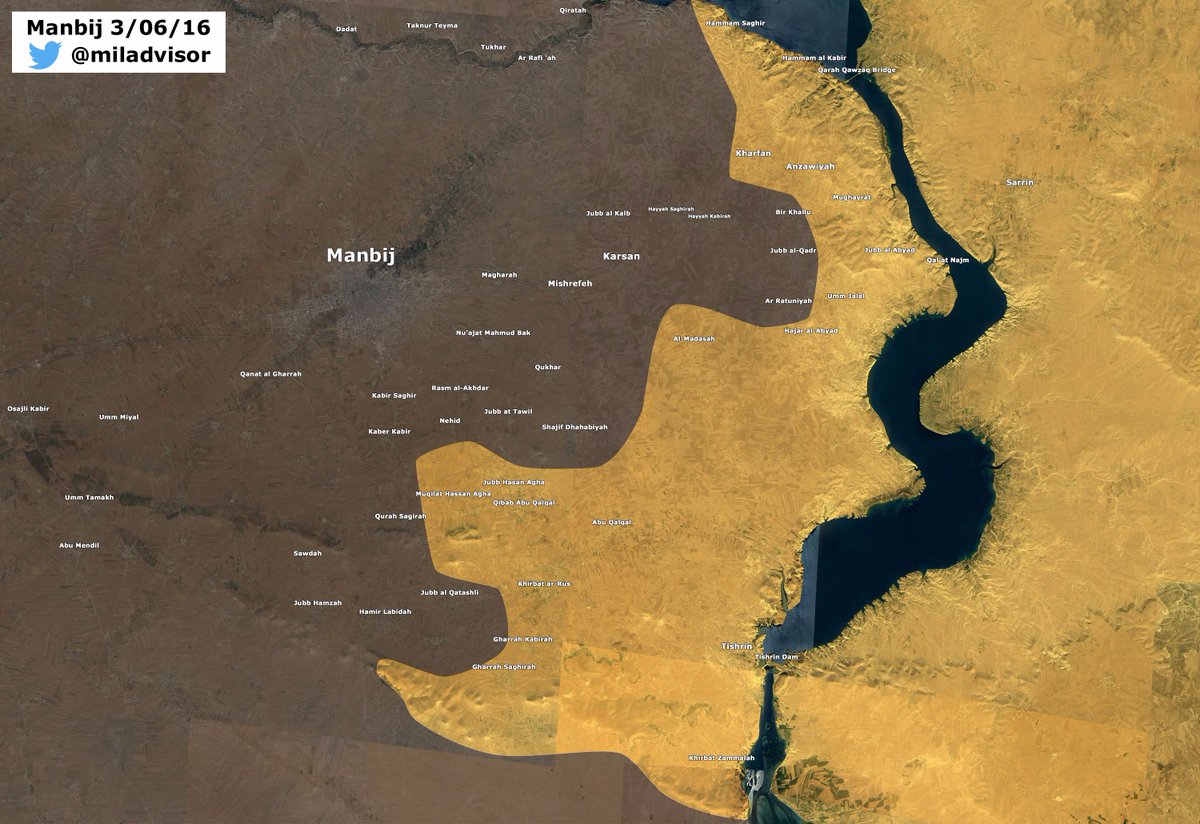
Military Advisor @miladvisor Jun 3
#Manbij Situation map 3/06/16.#SDF/#YPG ~6km from the south
entrance of city.
Re: Levant crisis - III
turkiye destruction of kurdish towns in turkey.
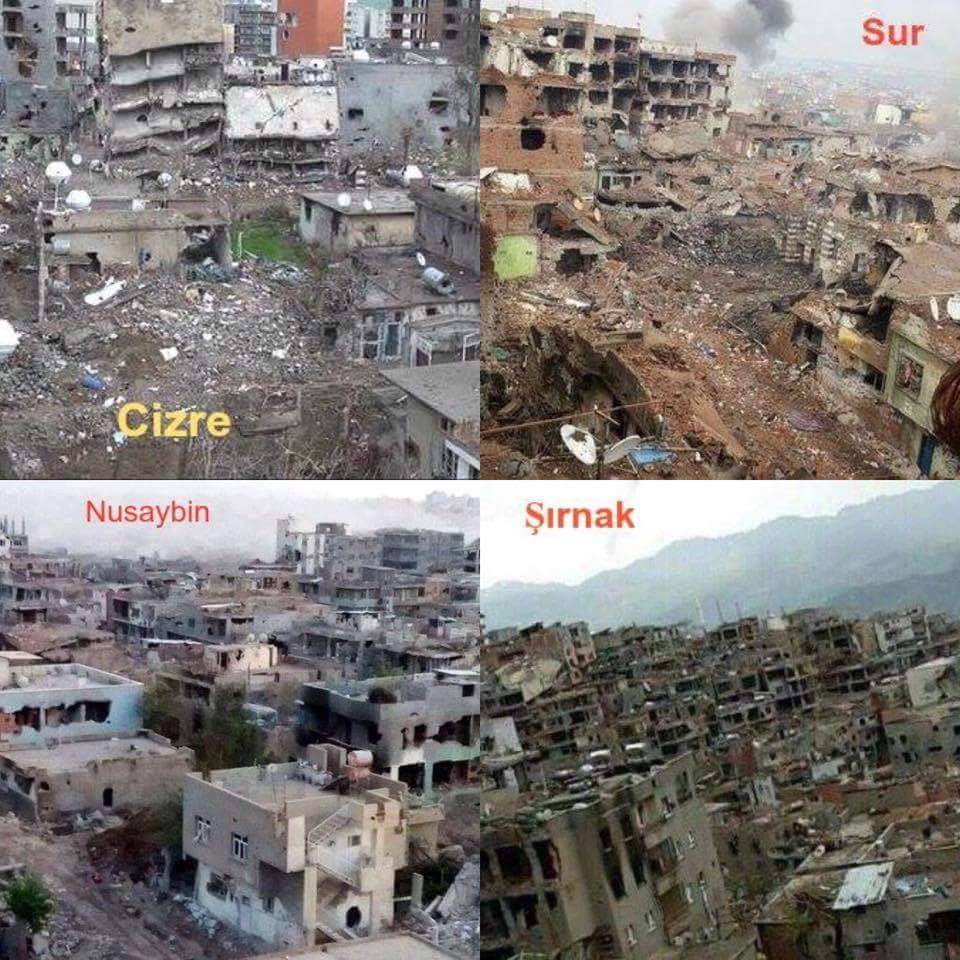

Re: Levant crisis - III
first scout units must on outskirts of the town to locate targets and channels of advance
Dr Partizan @DrPartizan_ 11h11 hours ago
#Manbij Reports from a Kurd near the fronts is that SDF are 2km from Manbij in the South and 6km from Manbij in the North.
Dr Partizan @DrPartizan_ 11h11 hours ago
#Manbij Reports from a Kurd near the fronts is that SDF are 2km from Manbij in the South and 6km from Manbij in the North.
Re: Levant crisis - III
Dr Partizan @DrPartizan_ 14h14 hours ago
#Manbij Civilians in liberated village of Neîmiyê ask why it took SDF 6 months to arrive. Answer is Turkey.
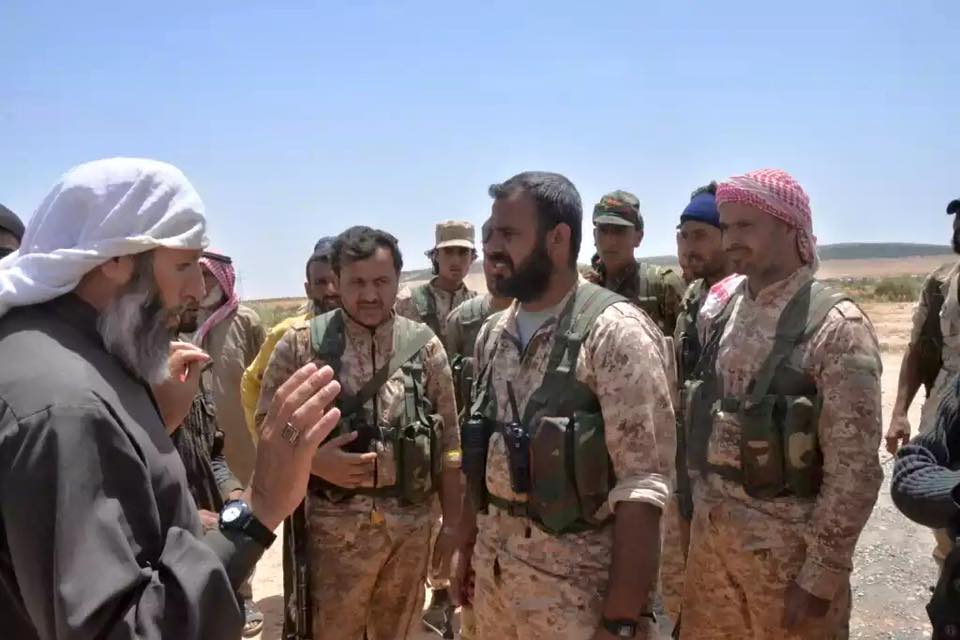
#Manbij Civilians in liberated village of Neîmiyê ask why it took SDF 6 months to arrive. Answer is Turkey.

Re: Levant crisis - III
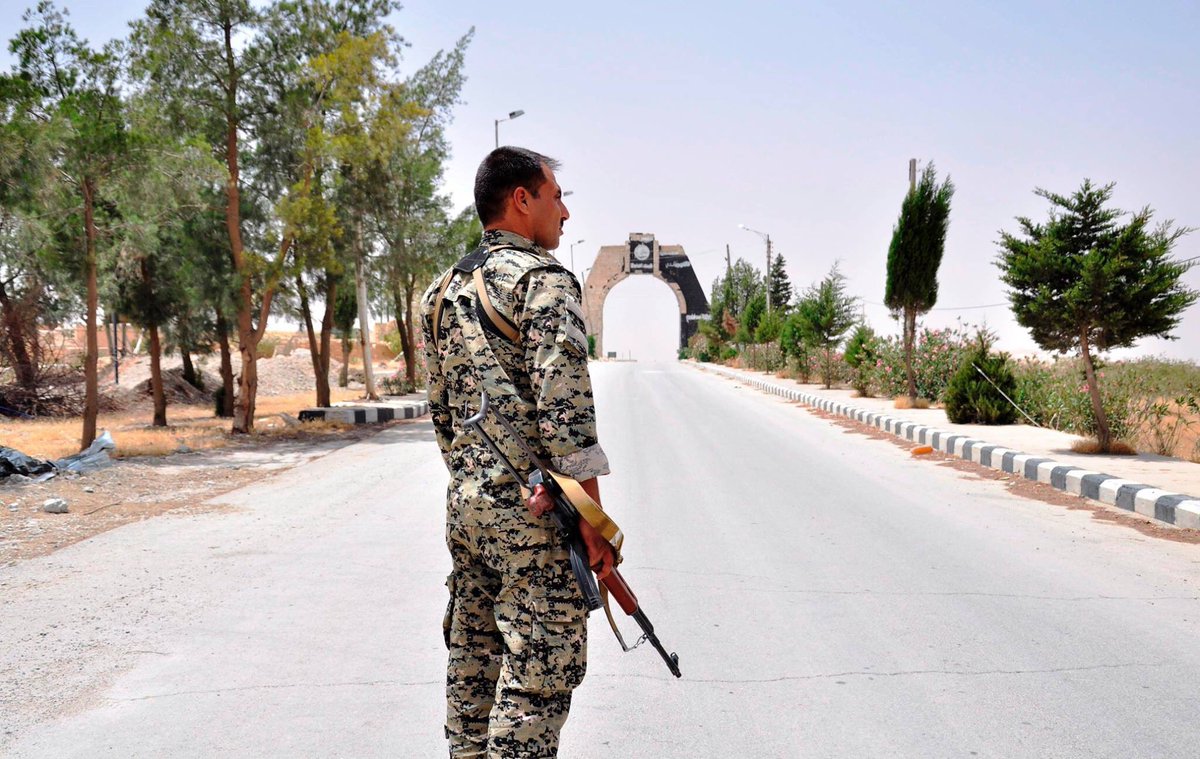
Dr Partizan @DrPartizan_ 15h15 hours ago
#Manbij YPG fighter says this is a photo of him in an area under administration of Manbij city.
Re: Levant crisis - III
the unit talking to the arab civilian in pic link above are clearly not kurd but some arab militia moving with the kurds.
Re: Levant crisis - III
https://pbs.twimg.com/media/CkNF--cXEAA9Uxp.jpg
fake HMG weapons factory in manbij to mislead aircraft
fake HMG weapons factory in manbij to mislead aircraft
Re: Levant crisis - III
manbij grain silos visible in distance some 10k away
https://pbs.twimg.com/media/CkK-SH-WkAAU0yI.jpg:large
https://pbs.twimg.com/media/CkK-SH-WkAAU0yI.jpg:large
Re: Levant crisis - III
attempt being made to repair qara qokzak bridge which was blown at both ends by daesh.
perhaps rocks and soil to fill up the first span for a ramp , topped with concrete layer will work as the river is not turbulent
https://pbs.twimg.com/media/CkM9z3lWgAAsCBN.jpg
perhaps rocks and soil to fill up the first span for a ramp , topped with concrete layer will work as the river is not turbulent
https://pbs.twimg.com/media/CkM9z3lWgAAsCBN.jpg
Re: Levant crisis - III


http://www.washingtoninstitute.org/poli ... _k.twitter
Raqqa Will Not Fall Until Arab Tribes Fight the Islamic State
Fabrice Balanche
June 3, 2016
The tribes in eastern Syria have been driven in different directions by the Assad regime, outside actors, and their own self-interest, leaving the coalition with a complex web to untangle before it can fully uproot IS.
This week, Kurdish and Arab fighters from the Syrian Democratic Forces pushed west into Islamic State-controlled territory in a bid to seize the town of Manbij. Only days earlier, however, the beginnings of a longer southward campaign -- to retake the IS "capital" of Raqqa -- were set in motion when the SDF began attacking IS positions in Balikh Valley, about fifty kilometers north of the city.
The latter offensive is far from a blitzkrieg that will bring the SDF to the outskirts of Raqqa promptly; for one thing, the Kurds may be distracted by their oft-stated goal of continuing westward toward Afrin in order to link up their two border enclaves (see PolicyWatch 2542, "The Die Is Cast: The Kurds Cross the Euphrates"). Yet the SDF's main military patron, the United States, has another reason to be cautious about the Raqqa timeline -- before the coalition even thinks about launching a final push on the city, it must rally the Arab tribes in the area, some of whom have pledged allegiance to IS. Any such effort will require a thorough understanding of the evolving role that tribes have played there, first under the Assad regime and now under IS rule.
TRIBAL STRUCTURE IN SYRIA
In Syria as in other countries, a tribe (ashira) is an ancestral network comprising anywhere from a few thousand to tens of thousands of members, subdivided into clans (shabba). Although clans generally compete for control of their tribe, they show solidarity in the face of outside danger.
During the Ottoman period, some tribal federations (e.g., the Shammar) were powerful enough to avoid paying imperial taxes, earning them the moniker "noble" tribes. Those who did pay are regarded as "common" tribes in the Bedouin hierarchy. Many common tribesmen still harbor animosity against their "noble" counterparts after being dominated by them for centuries.
While the noble tribes have retained their transnational nature and patronage ties with Saudi Arabia, the common tribes are more rooted in the Syrian state and have largely abandoned their nomadic lifestyle. These differences shaped their response to the 2011 uprising. When anti-regime protests first emerged, tribes with Saudi links took part early on, which explains why Deir al-Zour province rapidly shifted toward the opposition. Yet Raqqa province remained loyal for longer because common tribes are more numerous there, and they had benefited from decades of agrarian reform and development projects launched by the Baath regime.
THE REGIME'S APPROACH TO TRIBES
In the 1960s, the Baath regime was very hostile toward representatives of major tribal confederations, actively dispossessing them of their land. In response, some leading sheikhs left the country, while those who remained in Syria were eventually coopted.
The construction of Thawra Dam and the launch of the Euphrates Valley Irrigation Program in the 1970s greatly facilitated this process. The regime integrated tribal elites by giving them positions in the state apparatus, and some were quick to appropriate the best irrigated fields. As expert Myriam Ababsa pointed out in a 2010 paper, this led to the emergence of a Baathist tribal generation that used its newfound political weight to gain power within the tribal hierarchy, which in turn fostered deeper tribal allegiance to the regime.
Ultimately, however, this new framework did not work in the national interest because many of the coopted tribesmen were simply using state resources to further their own local interests. As a result, the regime's irrigation program became an economic fiasco, with tribal politics taking precedence over development. By the time Bashar al-Assad succeeded his father Hafiz in 2000, the project was collapsing -- the government could not afford to extend the irrigation system any further, and efforts to reform agricultural and water policies were blocked by bureaucracy and political patronage (see PolicyWatch 2622, "Water Issues Are Crucial to Stability in Syria's Euphrates Valley"). Tensions were further exacerbated by the area's high fertility rate, which was essentially doubling the population every twenty years.
In short, the Euphrates project allowed the regime to rent -- not buy -- the local tribes. Although the Raqqa region was loyal to Assad until as late as 2013, years of agrarian policy failures and the influx of money from Gulf countries ultimately pushed most tribal leaders toward the opposition. Even so, some sheikhs remain loyal today and have fled to Damascus, where they enjoy protection because the regime hopes they will be useful once it retakes the Euphrates Valley.
The regime has also employed military means to coopt tribes. The army began recruiting heavily in the Euphrates area during the 1980s, and many residents of this underdeveloped region came to view military service as a social elevator. That same decade, Hafiz al-Assad used the Haddadin tribe to fight the Muslim Brotherhood in Hama, eventually destroying the rebellious city. Today, the Haddadin are helping his son fight rebel forces and protect the Aleppo supply road east of Hama, while prominent sheikh Fahd Jassem al-Freij serves as Bashar's defense minister. Similarly, the younger Assad did not hesitate to distribute weapons to Arab tribes in Jazira when facing a Kurdish revolt in 2004. These tribes -- the Jabbour, Adwan, Tay, and Ougaidat -- are still fighting with him today because they fear their enemies will take revenge if he loses power. This explains why the army is able to control a pocket in the middle of Kurdish territory south of Qamishli.
THE ISLAMIC STATE'S TRIBAL POLICY
After establishing itself in eastern Syria during the war, IS quickly integrated the tribes into its own system. Once local sheikhs pledged allegiance to the supposed IS "caliph," they were asked to marry their daughters to high-ranking IS members and send their sons to fight with the group. IS gave oil wells, land, and other benefits to those who voluntarily joined it, but attacked those who resisted its hegemony (e.g., massacring 700 members of the Sheitat tribe in August 2014).
Like the Baath regime before it, IS has sought to create an independent social base out of the traditional tribal hierarchy. If an elder sheikh is hesitant to cooperate, the group promotes a younger son or a secondary clan within his tribe. But it focuses its most intense efforts on adolescents, who are drawn into camps for ideological indoctrination and military training. Over the past three years, thousands of young men have been radicalized and detribalized, which will raise a serious rehabilitation problem once IS has been defeated.
The group also uses conflicts between tribes to impose its power. In Jarabulus, IS supported Tay tribesmen against the Jais tribe, forcing the latter to leave the city and seek refuge in Turkey (it is unclear what relationship the attackers had with the main Tay tribal stronghold on Syria's far northeastern border, though the war has at times spurred groups of tribesmen to leave their traditional territory). And in August 2013, IS helped the Arab tribes of Tal Abyad defeat Kurdish fighters from the People's Defense Units (YPG), expel all Kurds from the district, destroy their villages, and redistribute their land to Arabs. Interviews with local observers confirm the Islamic State's objective in such cases: to play on Sunni Arab fears of Kurdish irredentism.
LOSING POPULAR SUPPORT
Even if the different actors in the war make the Islamic State their main target, they will still need the local population to reject the group if they hope to fully defeat it. Existing factors will help in this regard, such as local economic deterioration, the group's heavy repression, and its gradual loss of legitimacy. But rallying the sheikhs will also require giving them money, political positions, and judicial immunity.
In the beginning, IS generously distributed food by emptying state grain silos. The price of bread was cheaper in Raqqa than in the rest of Syria, and fuel cost less because it was produced and refined locally. Yet the group's strict price controls are no longer curbing inflation, especially as agricultural production decreases -- a function of scarce fertilizers and pesticides, heavier taxation on farmers to compensate for declining oil revenue, and an irrigation system beset by infrastructure damage and mismanagement. Farmers in irrigated areas are subject to the same unpopular constraints they faced under Assad, but with decreased income.
Meanwhile, the myth of an Islamic order that provides justice to all of the faithful has faded. Recent interviews with refugees from Deir al-Zour and Raqqa provinces indicate that IS courts are just as corrupt as Assad's, with the group's members and their families receiving preferential treatment despite the occasional token execution of corrupt IS fighters. Conscription and enlistment of adolescents has provoked protests (e.g., in Manbij in November 2015), spurring IS to increase repression to keep the population in check.
Given their growing desire for revenge (intiqaam) and their traditional tendency to preserve tribal interests above all else, many individuals and entire clans are ready to help those fighting IS, whether the SDF or the Syrian army. For example, 200 members of the Sheitat tribe joined the army in Deir al-Zour after the 2014 massacre, and tribal collaboration helped the regime retake Palmyra this March. As the army and SDF approach Raqqa, tribal defections around Deir al-Zour and Manbij are multiplying.
PREVENTING TRIBAL WAR AFTER THE ISLAMIC STATE
The United States has been backing the SDF via the YPG and its Kurdish parent organization, the Democratic Union Party (PYD), and such support -- namely, the promise of air support and better weapons -- is essential for encouraging tribes to join the anti-IS coalition. Arab tribes from the Fadan federation have already joined the YPG in Raqqa province, while several Shammar tribes in Hasaka province helped YPG units capture al-Hawl and al-Shadadi from IS last winter. These tribes have always had good relations with the Kurds; for example, they refused to help Assad repress the Kurdish uprising of 2004. Yet they are relying on Washington to moderate the PYD's hegemonic tendencies and ensure their own share of power once IS has left.
The same process is taking place in the northern part of Raqqa province, but with many more obstacles. Some tribes remain fiercely on the Islamic State's side (e.g., the Afadla and Sabkha), and those who have been expelled from their lands by IS-backed tribes are not ready for quick reconciliation (e.g., the Jais and Sheitat). As a result, the SDF is reaching the limit of how many more tribes it can integrate, and spurring a general uprising against IS would be very difficult without neutral foreign troops on the ground. The level of violence has been so high since 2011 that the traditional tribal measures of regulating it are no longer adequate -- several clans and tribes will be forced to flee to avoid collective vengeance, such as the Tay in Jarabulus and the Sbaa in Sukhna (who originally helped IS capture Palmyra).
To stem intertribal violence and chaos after IS, the coalition will need to fill the political vacuum immediately. But conducting free elections is not feasible in the near term, so the new authorities will have to coopt local notables to manage cities and districts during the transition, as Gen. David Petraeus did in Mosul, Iraq, in 2003. The question is whether this is possible without a neutral military force present. The PYD cannot simply transplant its administrative experience from Hasaka and Kobane to non-Kurdish cities such as Raqqa and Deir al-Zour; in fact, the group has been accused of ethnic cleansing in the predominantly Arab town of Tal Abyad.
The alternatives present problems as well. If Arab tribes in the Euphrates Valley are left to organize themselves, they could easily devolve into fighting over cities, land, and water -- especially around Thawra Dam, the key to local irrigation and power generation. The Kurds would likely stay out of such conflicts because they have no territorial ambitions in that area, but IS could return, perhaps under a different name. The Syrian army is also close to both the dam and Deir al-Zour, so Assad has not lost hope of exploiting tribal loyalties and fears to regain control there. In short, stabilizing the Euphrates Valley post-IS will be a major financial and political challenge.
Fabrice Balanche, an associate professor and research director at the University of Lyon 2, is a visiting fellow at The Washington Institute.
Re: Levant crisis - III
Picture: Tu-142M3 Sea Russian Navy aircraft used in Syria to reconnaissance of ground targets.
http://bmpd.livejournal.com/1941736.html
Picture: T-90 used for offensive on the Raqqa
http://bmpd.livejournal.com/1941039.html
http://bmpd.livejournal.com/1941736.html
Picture: T-90 used for offensive on the Raqqa
http://bmpd.livejournal.com/1941039.html
Re: Levant crisis - III
over the past month I seem to be the onlee one posting on this thread !! are people really reading this thread I wonder ?
if anyone is reading the posts and finding some value in it, could you pls reply with a +1
if none are reading, I might just as well save time by reading the original sources and not copying any links and materials here
if anyone is reading the posts and finding some value in it, could you pls reply with a +1
if none are reading, I might just as well save time by reading the original sources and not copying any links and materials here
Re: Levant crisis - III
+ 1
Singha . I check this thread a few times everyday
Singha . I check this thread a few times everyday
Re: Levant crisis - III
Also because of you, i have started checking the twitter feeds of the ppl you link to. But esp lap the succinct summary each day.
Re: Levant crisis - III
Austin could it be a ELINT and not ASW bear ?
the ASW kit like mad, sonobuoys, sea search radar, passive EW direction finder etc would be useless for land targets.
their specialized tu214r is already in syria
https://theaviationist.com/2016/02/15/t ... -to-syria/
it could have been dropping off short range cruise missiles in a new tests or just passing by after snooping on some nato exercise in the med. there have been periodic flights of blackjacks also over syria but without fanfare.
the ASW kit like mad, sonobuoys, sea search radar, passive EW direction finder etc would be useless for land targets.
their specialized tu214r is already in syria
https://theaviationist.com/2016/02/15/t ... -to-syria/
it could have been dropping off short range cruise missiles in a new tests or just passing by after snooping on some nato exercise in the med. there have been periodic flights of blackjacks also over syria but without fanfare.
Re: Levant crisis - III
+!!!! Always ck into it .Most inforkept a secret forever.maticxan't be ve. Far more relevant info than the "Beeb",etc.The beginning of the end game is now playing out with Raqqa,Fallujah,etc covert coop between the US and Ru. Aim to eliminate.reduce as much as pos. the influence of ISIS so that oil prices can be stabilised,low prices which are threatening the global economy,esp the Soothis,US bum-chums.
These "rebel" forces are actually mostly mercenary outfits with embedded western covert spl forces! That's why the plea to Russia not to bomb them,as western casualties cannot be kept secret forever.
http://www.telegraph.co.uk/news/2016/06 ... de-rebels/
These "rebel" forces are actually mostly mercenary outfits with embedded western covert spl forces! That's why the plea to Russia not to bomb them,as western casualties cannot be kept secret forever.
http://www.telegraph.co.uk/news/2016/06 ... de-rebels/
British special forces 'operating inside Syria alongside rebels'
Special forces of the Syria Democratic Forces fighting to take control of Manbij, Aleppo
By Our Foreign Staff
6 June 2016
British special forces are operating on the front line against the Islamic State of Iraq and the Levant in Syria, according to rebel commanders.
The Times reports that they have been defending a rebel unit against Isil attacks, marking the first evidence of the troop's direct involvement involvement inside Syria rather than training fighters in neighbouring Jordan.
First Lieutenant Mahmoud al-Saleh said British forces frequently crossed the border to help the New Syrian Army (NSA), comprised of former Syrian special forces, as it defends the south-eastern village of al-Tanf.
“They helped us with logistics, like building defences to make the bunkers safe,” he said.
Civil defence members try to put out a fire after air strikes in Idlib, Syria
The NSA snatched al-Tanf – which occupies an important location close to the Iraqi and Jordanian borders - from Isil in May.
The rebels now face regular attacks as the jihadist movement tries to take it back.
“They attack us at all times, 3am, 5am, 4pm, 11pm. If you look at the timing of the assaults it’s clear they don’t want us to get any rest. They’re using missiles, mortars and many suicide bombers,” said Lt al-Saleh.
According to The Times, the group's base in the town was hit by a suicide attack last month and British forces helped with rebuilding it.
Since starting with a 2011 crackdown on anti-government protests, Syria's conflict has evolved into a complex, multi-front civil war that has left more than 280,000 dead and forced millions from their homes.
Isil emerged from the chaos in mid-2014, seizing control of large parts of the country and neighbouring Iraq, declaring a fundamentalist Islamic "caliphate" and committing widespread atrocities.
Iraqi forces attack Islamic State-held Fallujah Iraqi forces attack Islamic State-held Fallujah Play! 00:52
Iraqi forces have been steadily regaining ground against the jihadists, and late last month began a major offensive to retake the city of Fallujah, just 30 miles west of Baghdad.
Meanwhile American-backed fighters advanced on Sunday to within three miles of Isil's stronghold of Manbij in northern Syria, threatening a crucial jihadist supply line.
The assault by the Syrian Democratic Forces adds to the pressure on Isil as it faces another offensive by Russian-backed regime troops in its bastion province of Raqqa.
Supported by air strikes by the US-led coalition, the SDF alliance of Kurdish and Arab militias has made steady gains since launching the operation against Manbij last week.
Re: Levant crisis - III
http://www.cbsnews.com/news/isis-slaugh ... for-spies/
daesh on a blood soaked hunt for moles and spies
daesh on a blood soaked hunt for moles and spies
Re: Levant crisis - III
This is true Mi-28N versus the Beardies near Palmyra 
Looks to me heavy ground fire from beardies
Looks to me heavy ground fire from beardies
Re: Levant crisis - III
They look like pure Naval Tu-142M with MAD and stuff , if this is the Novella Upgrade one ( hard to tell ) then the SAR/ISAR mode of radar can be used .......or just could be the Russias are testing their new gadgets in a opportunity like this.Singha wrote:Austin could it be a ELINT and not ASW bear ?
the ASW kit like mad, sonobuoys, sea search radar, passive EW direction finder etc would be useless for land targets.
their specialized tu214r is already in syria
https://theaviationist.com/2016/02/15/t ... -to-syria/
it could have been dropping off short range cruise missiles in a new tests or just passing by after snooping on some nato exercise in the med. there have been periodic flights of blackjacks also over syria but without fanfare.
Re: Levant crisis - III
Singha ji, been reading and checking your updates regularly. Unable to follow as earlier due some other fruitful engagements. Thank you for keeping us updated.Singha wrote:over the past month I seem to be the onlee one posting on this thread !! are people really reading this thread I wonder ?
if anyone is reading the posts and finding some value in it, could you pls reply with a +1
if none are reading, I might just as well save time by reading the original sources and not copying any links and materials here
Re: Levant crisis - III
tiger forces 4km from arak oilfield on the road to sukanah
https://pbs.twimg.com/media/CkQc-NHWkAArK0Z.jpg
https://pbs.twimg.com/media/CkQc-NHWkAArK0Z.jpg
